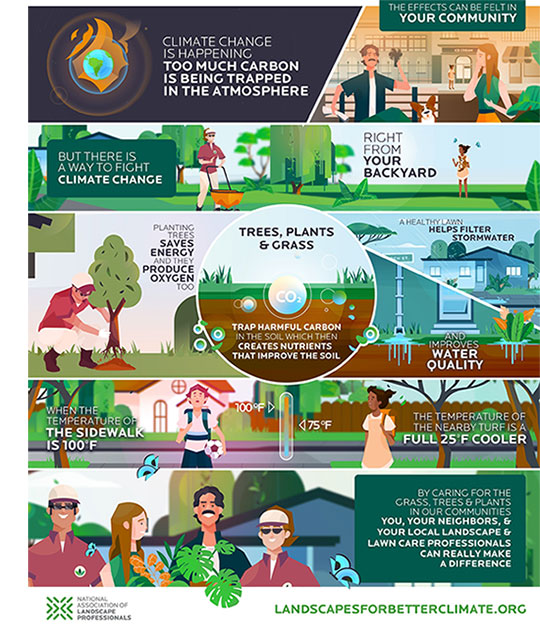 The Landscape and Nursery Sector is ALREADY poised to help with Climate Change
The Landscape and Nursery Sector is ALREADY poised to help with Climate Change
DID YOU KNOW?
The Landscape and Nursery Sector can provide expertise for living green infrastructure to assist in climate resilient infrastructure such as flood mitigation, reducing urban heat islands, improving air quality and carbon sequestration. Living Green Infrastructure is an interconnected network of green spaces that provide a range of ecosystem services – from clean air and water to wildlife habitat and carbon sinks. This includes open spaces, and landscaped areas within the urban environment.
Grey infrastructure, such as pipelines and sewers, is the traditional practice for stormwater management and wastewater treatment. Everyone has seen the impact of heavy spring runoff with flash floods that cause great destruction and catastrophic loss of these manmade drainage systems. As we continue this practice, we are likely to see more flooding and breakdown of this traditional grey infrastructure at great loss and cost to our communities. The conventional approach to development has been to strip all vegetation and soil from the development site; install costly in-ground stormwater management systems; and to use paved impermeable roadways, driveways, concrete sidewalks, gutters, and catch basins which collect and channel rain and stormwater to rivers, ponds, and eventually the ocean. Clearly, this has an adverse effect on climate change, so there are numerous alternatives to consider.
DID YOU KNOW?
Living green infrastructure provides many economic benefits and further research can support the ecological and social benefits by reducing energy costs; managing stormwater; improving soil health; creating cleaner air and improving population health and well-being. It reduces building energy use and urban heat islands. Green roofs, green walls, turf and trees can make buildings more energy efficient and climate friendly by reducing heating and cooling demands and absorbing greenhouse gases. As cities expand, grey infrastructure continues to absorb and retain heat, while to balance, living green infrastructure naturally cools cities and compliments the grey infrastructure. Flooding is reduced as drainage layers and soils retain water and reduce stormwater volumes. Keeping rain out of the drains, combined sewers and sewer systems help reduce pollution and floods. Research indicates that shade trees planted in urban centres can save $.08591/m2 of tree canopy per year in energy dollars; shading pavement can reduce its surface temperature by up to 20°C which can increase its life expectancy by 10-25 years and cut maintenance costs in half. For every 1000 trees, nearly 1 million gallons of stormwater runoff is prevented.
There are many opportunities for the nursery and landscape industry to have a positive impact on climate change. We are the industry whose products and services, at all levels, sequester carbon. Living green infrastructure development begins with proper landscape design and planning that allows green infrastructure to compliment grey infrastructure and extend the lifespan of roads, roofs and pipes. The horticulture industry is a vehicle of information for what landscapes are and how they function in urban environments to mitigate the effects of climate change. The opportunity to educate the public, the government, and the youth of today are endless. From reducing the impacts of weather with windbreaks and shelterbelts to assisting municipalities in reducing maintenance costs and deriving new economic benefits we are already poised to help with climate change.
In the words of Albert Einstein “Look deep into nature and then you will understand everything better”



